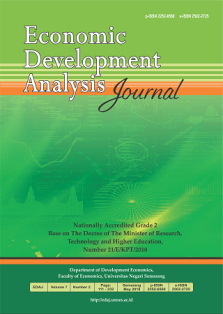Financial Inclusion, Poverty, Inequality: Empirical Evidence from Provincial in Indonesia
Abstract
Current financial inclusion studies generally use partial indicators from access and use dimensions and are still limited in using multi-dimensional indicators. This study investigates the nexus between financial inclusion, poverty, and inequality by looking at empirical evidence from 33 provinces in Indonesia during 2009 - 2019. The Financial Inclusion Index (FII) for each province is constructed following Wang & Guan (2017) approach, which is more objective in weight assignment and avoids correlations between dimensions, namely access dimension, and usage dimension. The results show that financial inclusion has a significant effect on reducing poverty in Indonesia. There is evidence that FII supports the existence of an inverted U-curve relationship between financial inclusion and inequality. If we dispart the FII, the result shows that the only access dimension has a significant effect on reducing poverty levels in Indonesia and supports an inverted U-curve relationship with inequality. To make financial inclusion a tool for combat poverty and inequality, Indonesia needs to provide broad and greater financial access, engage unbanked people to make an account, and use financial services, especially for poor people. Alongside that, Indonesia also needs to make usage dimension has an impact on financial inclusion. Financial institutions need to design the right products so that they can provide based on people's needs.


